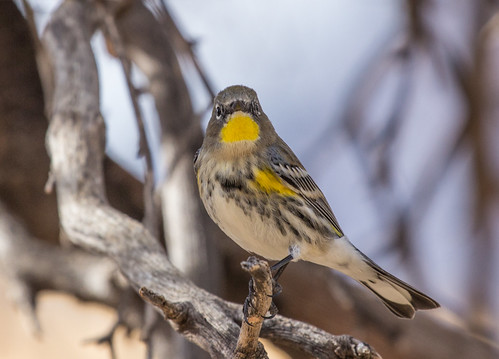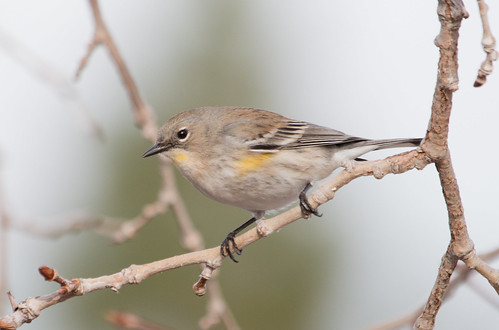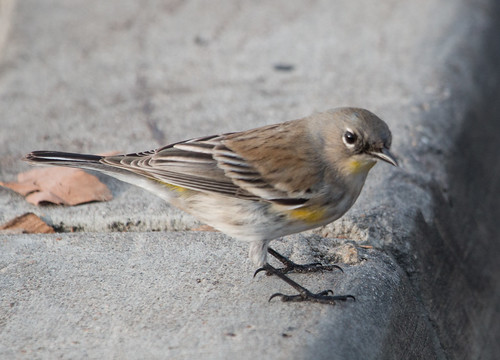Last month, the very day that I received an email about an out-of-place Yellow-rumped Warbler in Hovland, Minnesota, I was in San Diego,
watching Yellow-rumped Warblers all over the place. I was in southern
California for 9 days, and the one bird species our group saw every single day
without fail was the Yellow-rump. They seemed to be everywhere—not just in the
trees and shrubs but picking at bugs on parking lots and sidewalks, too.
Every one of them was the Western form of the species, called Audubon’s warbler. This form has a throat that can be anywhere between dull yellowish and bright yellow, unlike the white throat of our Eastern form, the Myrtle warbler, and the chip note sounds a little less dry than the tsk of the Myrtle. I wore my hearing aids every day, which made that once again an easy-to-discern distinction. I’ve been lucky enough to spend more time in the West in the past few years than ever before in my life, but until I got my hearing aids, the differences between those call notes had become hard to appreciate.
The Myrtle and Audubon’s Warblers were once considered
separate species, but were lumped into one species by the American
Ornithologists’ Union in 1973. That was before I started birding, so I didn’t
know the sad feeling of so many birders who lost a bird on their life list when
the two species were lumped. Now rumor has it that DNA research may soon lead the AOU to re-split them. I may wake up one morning, check the news,
and learn that I got a new lifer overnight without doing anything at all.
How are these issues worked out? One 2011 paper in Molecular Ecology explains some of the
genetic issues involved. First of all, the Audubon’s and Myrtle are not the
only forms of Yellow-rumped Warblers. The Black-fronted warbler of northwest
Mexico and Goldman’s warbler of Guatemala were also considered distinct species
until 1973, when all four were lumped into the Yellow-rumped Warbler because
some interbreeding was happening where their ranges overlapped, producing
hybrid young.
Alan Brelsford and his co-authors of the 2011 paper, “Hybrid origin of Audubon’s warbler,” found that Audubon’s warbler carries
a mixture of alleles otherwise found only in either Myrtle or Black-fronted warbler—neither of them shared those particular alleles with the other.
The researchers also
found that Audubon’s warblers carry two deeply divergent mitochondrial DNA
lineages, each shared with only one putative parental form. Mitochondrial DNA
is transferred by the mother to the young, and if Myrtle and Black-fronted warblers were the same species, their mDNA should not be so divergent.
Genetic
markers show that Audubon’s and Black-fronted warblers are still closely
related; the differences between them smooth out somewhat where their ranges
overlap. They conclude that Audubon’s Warbler arose through the hybridization
of two long-diverged species, the Myrtle and Black-fronted Warblers.
Of course, not one of the Audubon’s Warblers I saw in
California was aware of any of that. And if I’d tried to explain it, it would surely have turned its back on me. What does any sensible warbler care about genetics? They all focus on a much more compelling subject: bugs.


